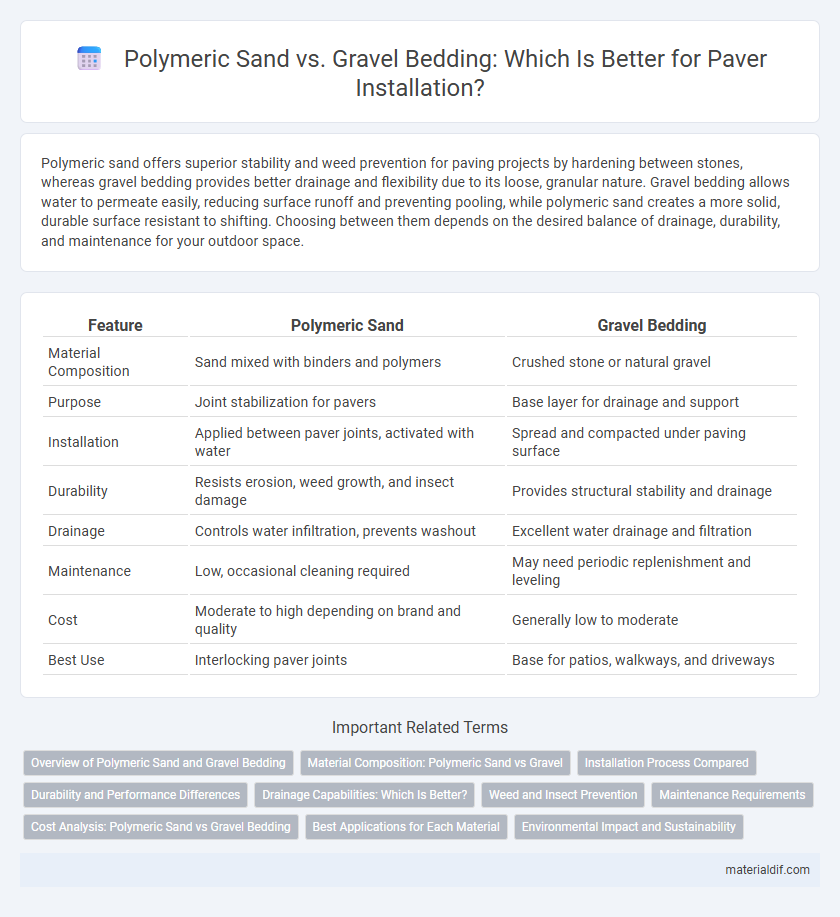Polymeric sand offers superior stability and weed prevention for paving projects by hardening between stones, whereas gravel bedding provides better drainage and flexibility due to its loose, granular nature. Gravel bedding allows water to permeate easily, reducing surface runoff and preventing pooling, while polymeric sand creates a more solid, durable surface resistant to shifting. Choosing between them depends on the desired balance of drainage, durability, and maintenance for your outdoor space.
Table of Comparison
| Feature | Polymeric Sand | Gravel Bedding |
|---|---|---|
| Material Composition | Sand mixed with binders and polymers | Crushed stone or natural gravel |
| Purpose | Joint stabilization for pavers | Base layer for drainage and support |
| Installation | Applied between paver joints, activated with water | Spread and compacted under paving surface |
| Durability | Resists erosion, weed growth, and insect damage | Provides structural stability and drainage |
| Drainage | Controls water infiltration, prevents washout | Excellent water drainage and filtration |
| Maintenance | Low, occasional cleaning required | May need periodic replenishment and leveling |
| Cost | Moderate to high depending on brand and quality | Generally low to moderate |
| Best Use | Interlocking paver joints | Base for patios, walkways, and driveways |
Overview of Polymeric Sand and Gravel Bedding
Polymeric sand consists of fine sand blended with specialized additives that harden when activated by water, providing enhanced joint stabilization and weed resistance for paving applications. Gravel bedding typically involves loose, coarse aggregates that offer excellent drainage and foundational support but lack the binding properties of polymeric sand. Selecting between polymeric sand and gravel bedding depends on factors such as surface stability requirements, water permeability, and long-term maintenance considerations for outdoor hardscape projects.
Material Composition: Polymeric Sand vs Gravel
Polymeric sand consists of fine sand particles combined with additives such as silica and polymer binders that harden upon moisture activation, providing a stable and weed-resistant joint filler. Gravel bedding is composed of coarse aggregates like crushed stone or pea gravel, which offer excellent drainage and load distribution but lack the binding properties of polymeric sand. The material composition difference directly impacts installation durability, with polymeric sand creating a hardened surface compared to the loose, permeable nature of gravel bedding.
Installation Process Compared
Polymeric sand requires a precise installation process involving spreading, sweeping into joints, and activating with water to harden and lock stones in place, providing enhanced stability and weed prevention. Gravel bedding preparation involves compacting a base layer of crushed stone or gravel, ensuring proper drainage and foundation before laying larger gravel stones. While polymeric sand focuses on joint stabilization, gravel bedding emphasizes creating a stable, well-drained foundation for durability.
Durability and Performance Differences
Polymeric sand offers superior durability compared to traditional gravel bedding due to its ability to harden and resist erosion, weed growth, and insect infestation. Gravel bedding provides excellent drainage and flexibility but may require frequent maintenance as loose stones can shift or wash away over time. For long-term performance in paving and landscaping projects, polymeric sand enhances stability and reduces the need for repairs, while gravel bedding remains a cost-effective solution with moderate durability.
Drainage Capabilities: Which Is Better?
Polymeric sand enhances gravel bedding by providing superior stability and preventing weed growth while maintaining moderate drainage capabilities. Gravel bedding offers more efficient water permeability due to its loose and porous structure, allowing quicker drainage and less water retention. For optimal drainage performance, gravel bedding outperforms polymeric sand, especially in areas prone to heavy rainfall or water accumulation.
Weed and Insect Prevention
Polymeric sand creates a hard, sealed surface that effectively prevents weed growth and insect infestations by filling gaps between pavers, unlike traditional gravel bedding which allows for weed seeds to settle and insects to nest easily. Gravel bedding, while providing good drainage, does not offer a solid barrier, making it less effective in weed and pest control. Using polymeric sand enhances landscape longevity by reducing maintenance related to weeds and insects, improving overall garden hygiene.
Maintenance Requirements
Polymeric sand requires less frequent maintenance compared to gravel bedding due to its ability to harden and reduce weed growth, erosion, and insect infestation. Gravel bedding often needs regular replenishment and raking to maintain an even surface and prevent displacement from foot traffic or weather conditions. The use of polymeric sand results in a more durable and low-maintenance joint filler for pavers and stones in landscaping projects.
Cost Analysis: Polymeric Sand vs Gravel Bedding
Polymeric sand generally costs between $0.50 and $1.00 per pound, typically requiring 1 to 2 pounds per square foot, making it more expensive upfront compared to gravel bedding, which averages $15 to $75 per ton depending on material and quality. Gravel bedding costs fluctuate based on gravel type and depth, usually totaling $1 to $5 per square foot for standard installations, offering a more affordable initial investment. Considering longevity and maintenance, polymeric sand's sealing properties reduce weed growth and erosion, potentially lowering long-term costs despite higher initial expenditure compared to gravel bedding's simpler, less costly installation.
Best Applications for Each Material
Polymeric sand is ideal for stabilizing paver joints in driveways, patios, and walkways, providing enhanced durability and resistance to weed growth and erosion. Gravel bedding is best suited for drainage systems, base layers under concrete slabs, and garden paths where water flow and structural support are critical. Each material serves distinct functions: polymeric sand excels in joint stabilization while gravel bedding offers superior load distribution and drainage.
Environmental Impact and Sustainability
Polymeric sand offers enhanced environmental benefits by reducing erosion and weed growth compared to traditional gravel bedding, minimizing the need for chemical weed treatments. Gravel bedding, while permeable and aiding natural water drainage, may contribute to sediment runoff and requires regular maintenance to prevent displacement. Choosing polymeric sand supports sustainable landscaping practices by stabilizing surfaces and decreasing environmental runoff risks.
Polymeric Sand vs Gravel Bedding Infographic

 materialdif.com
materialdif.com